
By Caitlin Adams, NOAA Office of Ocean Exploration and Research, Web Coordinator
September 22, 2017
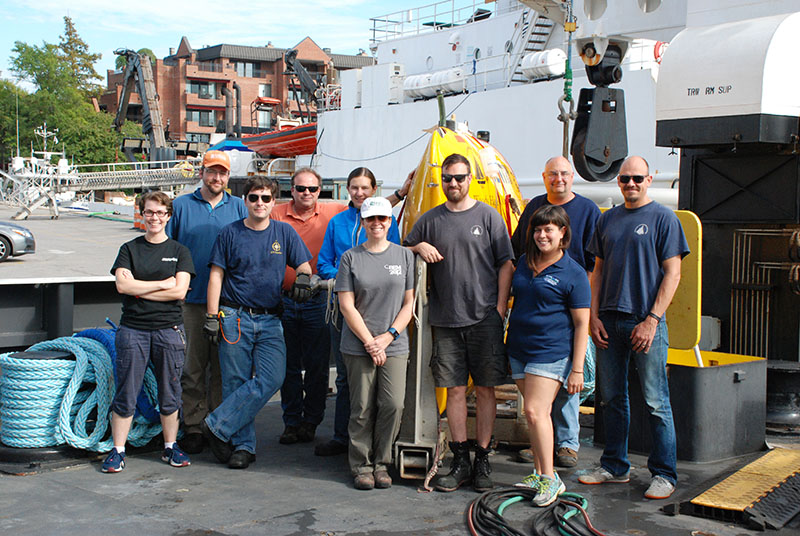
The DEEP SEARCH science team at the end of the 2017 expedition. Image courtesy of DEEP SEARCH 2017, NOAA-OER/BOEM/USGS. Download larger version (jpg, 5.4 MB).
It’s Friday, September 22—six days before the scheduled end of DEEP SEARCH 2017—and the Pisces is back in port in Norfolk, Virginia, to avoid yet another hurricane. While the forecasts still aren’t certain as to what Hurricane Maria will mean for the eastern seaboard, the DEEP SEARCH team has made the difficult decision to end the cruise this weekend.
The trouble with hurricanes is that even if they don’t make landfall, they’re still going to cause problems for a seagoing expedition such as ours. Maria could stay hundreds of miles offshore, and the seas still would be too rough for us to leave again until Wednesday—and that just wouldn’t give us enough time to do any more work.
Even though this marks the end of DEEP SEARCH 2017, it is by no means the end of the project. This is just the first of three expeditions, with many more days at sea ahead. This first cruise, in fact, is happening within a month and a half of the project’s start date! The team had to work quickly and collaboratively to prepare for this cruise, and much of the real work will begin now that we’re back on shore.
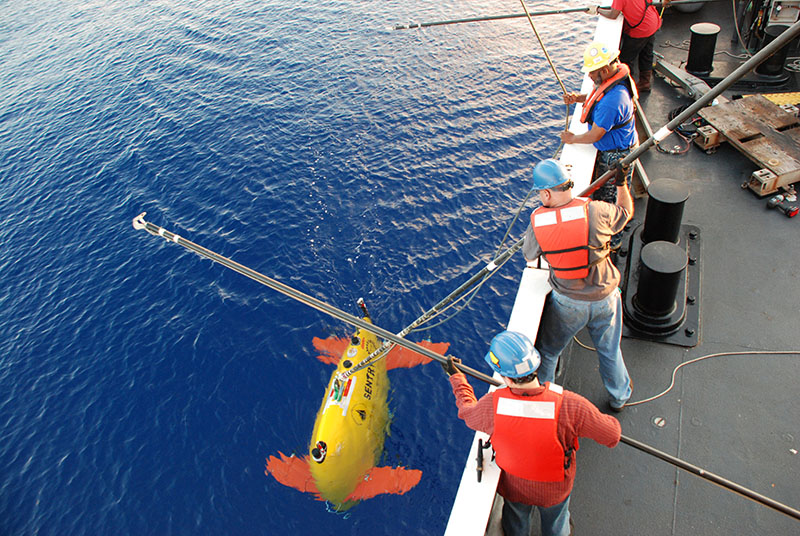
Members of the Sentry engineering team and the Pisces deck crew work together to hook the crane line to the Sentry and begin lifting the vehicle back onto the deck. Image courtesy of DEEP SEARCH 2017, NOAA-OER/BOEM/USGS. Download larger version (jpg, 5.9 MB).
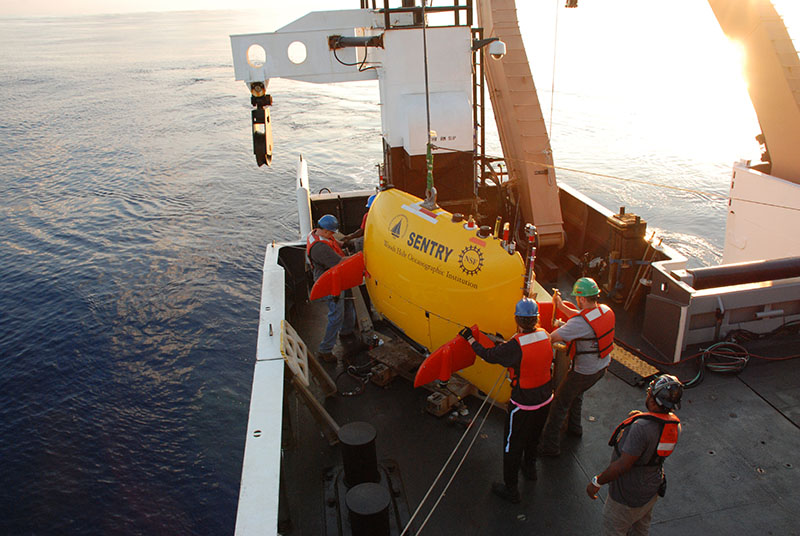
AUV Sentry is secured into its cradle after recovery for the last time during the DEEP SEARCH 2017 expedition. Image courtesy of DEEP SEARCH 2017, NOAA-OER/BOEM/USGS. Download larger version (jpg, 4.8 MB).
There are several lead scientists involved in this project, from six different academic institutions, contracted and organized through TDI-Brooks International, Inc, and from the U.S. Geological Survey (USGS). Erik Cordes (Temple University) is the project manager and his graduate student, Alanna Durkin, contributed significantly to this first cruise by processing the thousands of photos that autonomous underwater vehicle (AUV) Sentry captured. Tracey Sutton (Nova Southeastern University) was unfortunately unable to join due to Hurricane Irma, but plans to complete his component of the project on future cruises. Other scientists from the TDI team—Samantha Joye (University of Georgia), Andrea Quattrini (Harvey Mudd College), Jennifer Miksis-Olds (University of New Hampshire), and Sandra Brooke (Florida State University), and from USGS (Cheryl Morrison, Nancy Prouty, and Christina Kellogg), were not directly involved in this first cruise but will be utilizing the data we’ve collected to begin planning for the next two cruises.
In 2018 and 2019, the DEEP SEARCH team will complete two more expeditions to the mid- and south Atlantic to further investigate coral, canyon, and seep habitats. On these cruises, they will be using a submersible to capture video of the seafloor and to collect samples to bring to the surface. When we can, we will use the data we collected this year to better target dive sites, but we will also expand our range to include areas we were unable to reach on this first cruise.
Ultimately, the DEEP SEARCH team aims to gather enough information about these sensitive seafloor communities to develop predictive habitat models that would give scientists and managers an idea of where these habitats might be, even in places where we haven’t sent an AUV or submersible to the bottom to confirm.
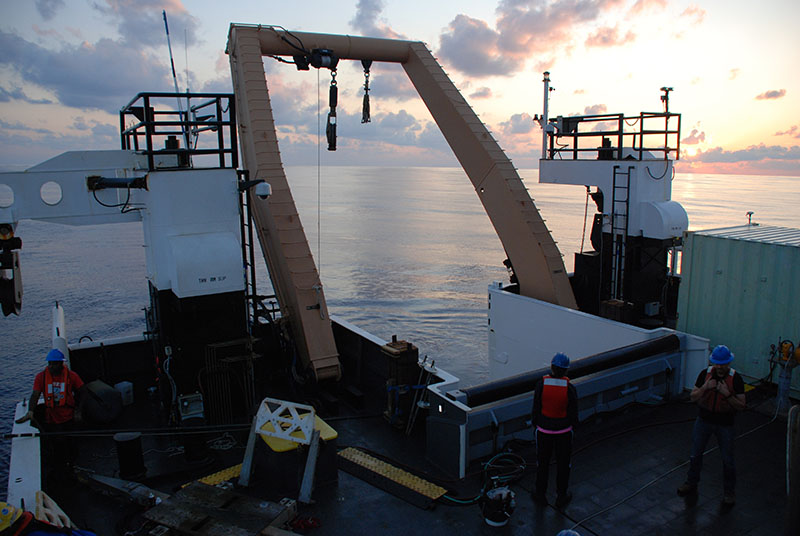
Though weather conditions began to deteriorate later that day, the seas were calm for Sentry’s recovery after its final DEEP SEARCH dive. Image courtesy of DEEP SEARCH 2017, NOAA-OER/BOEM/USGS. Download larger version (jpg, 4.4 MB).
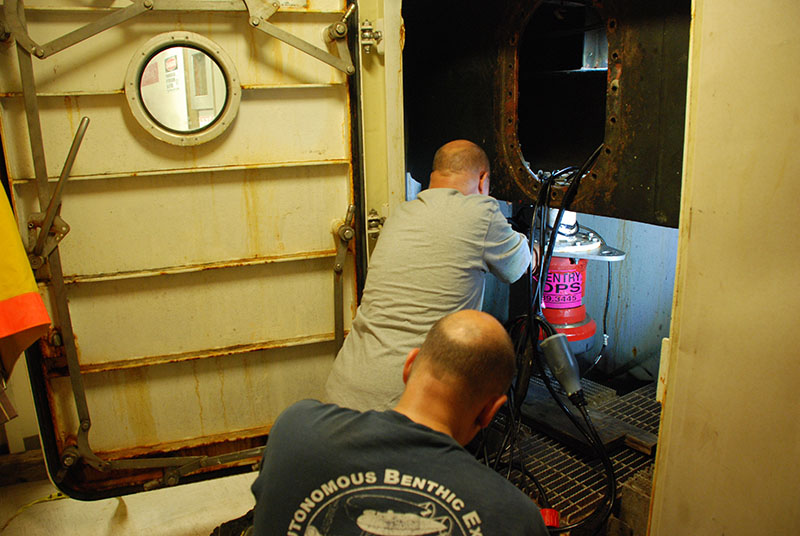
Upon return to Norfolk, Virginia, the Sentry team quickly got to work with the demobilization process to prepare for Sentry’s shipment to its next project. Here, Andy Billings and Mike Jakuba work to remove the AUV transponder from the Pisces centerboard. Image courtesy of DEEP SEARCH 2017, NOAA-OER/BOEM/USGS. Download larger version (jpg, 5 MB).
The DEEP SEARCH project isn’t the only initiative getting started this year, either. DEEP SEARCH is actually part of a much broader Atlantic coalition—the Atlantic Seafloor Partnership for Integrated Research and Exploration (ASPIRE)—that is bringing together scientists and managers from both sides of the Atlantic (European Union, Canada, and U.S.) to identify linkages between existing projects and collaboratively plan future initiatives when possible. The ASPIRE campaign, which has been envisioned to further the goals of the 2013 Galway Statement on Atlantic Ocean Cooperation , is only in its most nascent stage, but it will be exciting to see what can be achieved in the coming years!